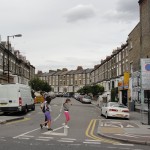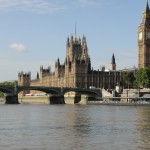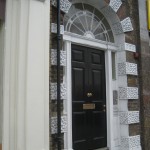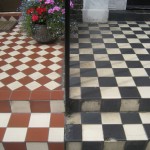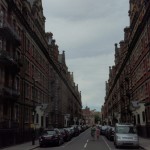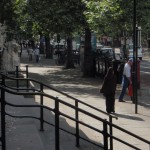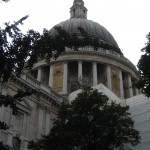The boat ride was a really great way to see London, today. It was incredible to see how much the Thames has stayed the same over the years (in that it is still a major waterway for transportation purposes) as well as how much it has changed (in that it is, luckily for us, no longer a cesspool of human and industrial wastes). The museums at the Royal Observatory were fascinating. I really thought a lot about the concept of time and what it means to our culture. That watches used to be a symbol of wealth and status, I think, is particularly poignant. The wealthy are, in essence, the ones who own time in that they own time of their employees, and therefore, to an extent, the employees themselves. Greenwich is an absolutely beautiful area and I plan on going back. I particularly enjoyed wandering around the market; I’m now especially excited for our East Street Market assignment tomorrow.
Greenwich & Time
August 21st, 2009 · No Comments
Tags: Anya
Notting Hill Gate
August 21st, 2009 · No Comments
Our stop was Notting Hill Gate, a posh residential area in the Borough of Kensington and Chelsea.The neighborhood seemed affordable and busy enough on first glance, but a turn onto a side street revealed nothing but lovely and large flats in a quiet neighborhood where everyone seemed to be at work.
As it is not a business district, shopping appears to be the main daytime activity in the Notting Hill/Kensington area. Shoppers, who seemed to be from other parts of London rather than tourists or locals, strolled by high-end boutiques and a few open air vendors on Portobello Road. On a Saturday, Portobello road would be packed for the local market.
Notably, there are no statues or monuments per se in Notting Hill. However, a plaque on Portobello Road indicates that George Orwell lived in a house there at an unspecified time in his life. This led us to wonder how different the neighborhood might have been when he was there, as he was not wealthy and actually spent time early in his career writing about the desperately poor in London and elsewhere.

Tags: Aidan · Uncategorized
second full day in London
August 21st, 2009 · No Comments
Today ended up being a long day of walking after our boat ride down the Thames. It was a beautiful day for both walking around the city and being out on the river. The boat ride, for me at least, was a nice introduction to some of the more touristy sites I relate to London in my mind. I particularly enjoyed the fact that it was a perfect spot to appreciate the bridges of London and the architecture along the Thames. Greenwich was a wonderful experience, especially since I have wanted to visit there since I was about eight years old. The museums concerning the clocks and observatory were wonderful. I especially liked the layout of the clock museum and how it presented the problem of telling time at sea and how they finally developed the solution for it. And the planetarium was very good. The presenter had a wonderful sense of humor, while still being very informative.
After lunch, I went to the market with Mara, Sarah and Alli. It was a very diverse market with numerous stalls and items for sale. We ended up spending a few pounds on henna tattoos. After this we walked to St. Alfege’s Church and even though we couldn’t go inside the church it was worthwhile to see the architecture and look at the old gravestones. From here we decided to make our way under the Thames and find a rail station to come back to the hotel. Well, we found a park, Millard Park, by the station and thought that it was a good idea to go into the park and investigate. Well, we ended up finding a farm. There were loads of animals there: pigs, cows, goats, sheep, chickens and horses. I especially appreciated the equestrian center we found with the farm. I knew that there are numerous stables and equestrian centers throughout the countryside, but I wasn’t expecting to find one in Greenwich. After walking through the farm, we decided to make our way back to the hotel on the train from the Mudchute Station. Overall it was a long day of walking and exploring, that lead us to find many different aspects of London and how this city is unpredictable.
Tags: Kimberly · Uncategorized
Alli and Anya's Trip to Marylebone
August 21st, 2009 · No Comments
We began our trip by hopping on the tube at the Goodge Street Station. We took the Central Line to the Oxford Circus interchange and then took the Bakerloo Line north directly to Marylebone Station, which is a railway stop as well as a tube stop. Marylebone Station, in the governing authority of Westminster, is named after a nearby church, St. Mary’s, which was built on the shore of a small creek, or “bourne,” hence the name Marylebone. The ride was a relatively quick one, lasting only five or ten minutes.
Upon exiting the tube (in which one follows “Way Out” signs rather than “Exit” signs), we came into Marylebone Station, which looks rather like an indoor shopping mall, though it is open to the air. There were many vendors and kiosks, including a vendor with a beautiful variety of flowers.
We began to explore Marylebone Street, which has some beautiful buildings. Both of us being artists (though not art majors), we tended to observe the surrounding from a micro-vantage point, rather than macro, taking snapshots of small architectural details, interesting lines and color compositions, etc. In a more general sense, there was a nice mix of residential and commercial areas; a number of what appeared to be flats as well as chain- and fast-food restaurants and a lot of shopping.
The area was diverse ethnically as well. We saw people of all races and religions, including several darker-skinned women in full burkas. There were many South-Asian, Middle-Eastern South-American businesses, too.
We hopped on a bus and started to head home, then realized that we had not yet found a monument, so be got off the bus at the next stop and found the Westminster Council House.
The monuments we found were all plaques and engraved stones in the side of the Westminster Council House. The Westminster Council House is responsible for administering birth, death, marriage and citizenship certificates. The building was opened by Prince Albert on 27. March. 1920 and a stone was laid by the Princess 8.July.1914. Another plaque was posted on the building which was in recognition of residents of Westminster who fought in World War II. This plaque was dedicated by Alan Bradley for the 50th anniversary of Victory Over Japan day on 16. August. 1995.
We then got back on a bus, promptly got lost, and then decided to take the tube instead, as that’s what we both felt more comfortable with. And got lost again. About 2 blocks away from the hotel.
Despite getting lost several times, the experience boosted our confidence with navigating the tube system and we were even able to help others (including a confused woman from Utah) find the stops they were looking for. Overall, we had a great time and learned a lot!
Andrew and Audrey's Amazing Adventure to High Street Kensington
August 21st, 2009 · No Comments
To get to High Street Kensington, we took the Underground (fondly referred to as the Tube) on the Central Line from the Tottenham Court Road station west to Notting Hill Gate where we switched to the Circle District Line to get to our desired High Street Kensington destination. This jaunt was approximately thirty minutes in duration and was made confusing by the indecisiveness of directional walking. Does one stay to the left or to the right when walking through crowds? Apparently no one knows! The locals like to stick to the left but when one finds oneself in more tourist filled locations the rules are discarded completely.
We came out of the station to find a busy street full of shops of all sorts and bustling with people. To get our bearings a bit, we ducked into an alley way that led to a quaint garden and church. Thinking this was where we had to go, we spent time looking around the cemetery, school, park, etc around there. Europe at its finest. You couldn’t even hear the busy street literally right on the other side of the buildings. This was an area in the middle of London that had a true small town feel to it. When we reflected on why we were sent to that area, we realized that we were looking at something that had nothing to do with the name Kensington at all. So, we pulled out our London A-Z maps and discovered that if we continued to walk a block or so we would arrive at Kensington Palace and Gardens. Righto. Still, this microcosm, we think, is representative of London itself. You find this encompassing environment but if you take a step back you find that that very environment is composed of smaller factions that are just as enveloping as the larger one.
Now onto the Kensington we were supposed to find! The station seems to be in place to allow for the public to have access to the gardens. The governing body appears to be Kensington. Never have I seen a prettier place full of not only plants and beautiful vegetation but also just people enjoying themselves in a most relaxed and respectful fashion. People from every race and age were present including the wealthy and those sleeping on benches but we saw mostly young people out enjoying a beautiful day in the garden.
We strolled around what could have been an entire park but truly was only a small fraction of the area. Some of the many sights we saw included Kensington Palace, William the II’s Palace (now a busy tea shop), a statue of Victoria R., and George Frederick Watt’s statue of Physical Motion. Attracted to a shiny, gold something in the distance, we headed to what we later found to be the Albert Memorial across from the Royal Albert Hall. This beacon was truly breathtaking! Prince Albert was the husband of Queen Victoria. A social activist and a financier of the arts and sciences, the hall and this statue are dedicated to his memory as well as Victorian achievement. Perched around a sitting Albert are representations of Africa, America, Europe and Asia, all of which were in some way connected to British imperialism. Above him rest figures of farming, engineering, manufacturing, and commerce. Then at the top of the memorial stand virtuous angels. The monument as a whole is also an acknowledgement of the many artisans that Albert had worked fiercely to promote. Prince Albert not only purchased the land of South Kensington as a means to create an educational and cultural institution, but he also worked to have the Great Exhibition of 1851 in Hyde Park. Both these events may have led him to be memorialized at Kensington Garden. People memorialized King Albert by sitting around the base of his statue smoking (a commercial endeavor indeed!). Mostly middle class people were around the statue and on the street; that is, those who had time to spend on a Thursday afternoon lounging around a statue and park. Tourists were around the more famous locations in the garden but as you ventured further away from statues and palaces, the local people used the gardens for their function as a recreational park.
As we were on Kensington Street, we thought the best way to return to the Arran House would be to either take the Tube or a bus. Confused by which side of the street we had to be on to take the bus, we opted for the former. Taking a different route this time, we took the Circle District line to Glouchester where we transferred onto the Piccadilly Line and went up to Leicester Square. From there we went up the North Line to Nottingham Court Road where we proceeded by foot to the Arran House. We might mention, we were a might bit late. The Central Line proved to have top marks in efficiency that day.

Tube stop

the happy accident

Tags: Uncategorized
Tea with the Queen: Victoria
August 21st, 2009 · No Comments



After purchasing mobiles, we ventured to Goodge Street tube station at 14:55. After swiping our new oyster cards, we became intimidated by two massive elevators that seemed to lead nowhere. We were confused, so we asked an elderly British bloke which route we should take. Under the heavy accent we were able to discern the word “one”. After going down the elevator, and fiercely searching for our stop, we realized “one” actually meant “Warren”. We got off of the Northern line at Warren (which we later learned, was only a few blocks away from the Arran House). We wandered aimlessly through Warren Station, only to arrive at the southbound Victoria line just as train was pulling away. We studied our A-Z map, as we waited for the next train, to familiarize ourselves with the Victoria area. After two stops on the Victoria Line, we followed the “way out” signs toward what looked like a central area. The entire trip on the tube took a mere twenty minutes. We soon realized our destination would include a stop at Buckingham Palace. We used our A-Z map to navigate ourselves towards the Palace, only to realize after about fifteen minutes that we had been walking in the opposite direction. By turning the map we suddenly oriented ourselves and made our way back up past the tube station and continued on to the Palace.
Naturally, we chose to use Buckingham Palace as our monument. The building was constructed in 1703 as a local home. After many additions and renovations, Queen Victoria became the first monarch to reside within its walls. We also came to the conclusion that this is why the Tube stop is named Victoria. We were excited at the possibility of viewing “the changing of the guards” however, we were angry to have found a sign that said the next change would occur the next morning at 11:30. after crying for about a minute we pulled it together and took a few pictures……



We sat on the steps of Victoria Memorial and gathered our thoughts and studied our map. We took a walk over to St. James Park and found a bus route back to Tottenham Court. Our trip back was approximately thirty minutes and we arrived back at the Arran House at 17:00.
Observations: The city of Westminster, where the Palace is located, seemed like a high end area. There were many business men and women walking swiftly through the streets. We also realized the differences in architecture between the old shop buildings, and the new modern high rise hotels. Upon arriving at Buckingham Palace we noticed a stark difference in the type of people surrounding the monument. The monument attracted tourists of all nationalities and classes. After observing St. James Park and Green Park, which was nearby, we came to the conclusion that there was a lot more green space than we were used to for major cities. It was also much cleaner than many of the most popular attractions in the U.S.
It was an easy and fun adventure and a great way to learn the ins and outs of London.
Piccadilly Circus
August 21st, 2009 · No Comments
Starting our first of what’s bound to be many exhausting days, Team Grace Kelley journeyed to the far-away land of Piccadilly Circus via the Tube. We found the Tube to be easy, efficient, and foolproof. Our trek began at Goodge Street Station and took us to our transfer point at Leicester Square and on to Piccadilly. When we got off the train, we followed the clearly marked “Way Out” signs, right into the tourist heart of London. In front of us was a fountain and statue of Eros, commemorating Antony Ashley Cooper, Seventh Earl of Shaftesbury, for his philanthropic work. The monument was surrounded by tourists of every shape and size! As we wandered around the statue and the area, we heard at least six or seven different languages. People were taking pictures on the stairs of the statue and the Ripley’s Believe It or Not employees were “performing” for the tourists.
One of the more noticeable features of the Circus, or circle, was the juxtaposition between the Regency style architecture and the neon/plasma screen advertisements on the sides of the buildings. The Regency style uses a lot of white stone facades and vertical lines. This style was first implemented by John Nash and inspired interior decoration, as well as fashion trends (ex. pier waistline for women). It includes an abundance of rod-iron balconies and windows and uses symmetrical shapes, having similar elements to the Georgian style of architecture.
Piccadilly Circus, established in 1819, was named for Pickadilly Hall, the residence of a famous tailor who was known for selling the piccadills-style collar. Its central location in the City of Westminster makes it an ideal meeting spot and one of the most well-known places in London. Here tour buses, the Underground, and city buses converge at a fast pace onto the crowded streets. However, we encourage walking and found it a very easy journey back to the Arran House.
Piccadilly Circus is a tourist trap, but it one worth seeing… watch out for pickpockets!



Camden Town Adventures!
August 21st, 2009 · No Comments
So for our first independent day in London, Maddie and Andrew tubed (that’s a word now) to the oh so amazing Camden Town. Before we left, our only perception of Camden was from New Jersey, which is a shithole. Needless to say, we were both more than pleasantly surprised. Three stops down from Goodge St. we disembarked the train and feasted our eyes on the eclectic streets of Camden Town. To quote a friend of Andrew’s, it is “The Venice Beach of London.” He wasn’t kidding. It is a counter-cultural Mecca abundant with youthful vibes and great music. The town seemed to be divided into sections by musical genre. We initially entered into a world of punk rock, black leather corsets, and tattoo parlors. We traveled through a world of hippies, metalheads, new agers, and everything in between. It was a maze of marketplaces, reminiscent of the Middle Eastern shouk where merchants peddle their wares, expecting haggling.
Neither of us think we saw a single person over forty. It is a major hangout for youth, especially those musically oriented. Amongst the record shops and live music cafes, we encountered a diverse mix of people, sounds, and smells ranging from France to Bangladesh to Thailand and back. People from all walks of life are not only welcome, but encouraged to spend time in Camden Town. The people we spoke to were very friendly and eager to discuss their unique perspective as either a resident or frequenter of the area. Both of us agreed that our time in Camden will be never forgotten. Our mutual love of music and interesting people will guarantee that. We highly recommend that EVERYONE IN THE WORLD visits Camden Town.

Visit Camden or this guy will pierce you in your sleep!
St Pauls
August 21st, 2009 · No Comments
We took the tube in London for the first time. After getting our new phones we caught the Central Line from Tottenham Court Station to St Paul. We wandered around the church and than found the City of London where we walked around the financial and business district before catching the bus back to Tottenham Court Road. We picked the St Paul Cathedral as our monument which was under construction and found that most people in the area were wearing suits and walking very quickly and with purpose.
The stores in the area were very expensive and the banks were in incredible old building with amazing architecture. The people in the walking in the area were not very friendly but the people that worked in the storefronts were happy to talk. The area was not too busy when we visited since the majority of people in the area were working in the buildings we passed. One thing that was interesting was the number of historical plaques on the buildings. Thomas Beckett was born in one of the buildings in the City of London, and many other buildings had plaques along a similar theme. As we were walking along the street we came across a bus that was headed to Tottenham Court Road so we hopped on and ended our first excursion in the city of London!
Tags: Andrew F · Mara · Uncategorized
Tower Hill Tube Activity
August 21st, 2009 · No Comments
 On Aug. 20, 2009 we got on the Tube at the Goodge St. station. We took the Northern line to Embankment where we switched lines and headed toward District. We got off at Tower Hill. In total this trip took about 30 minutes.
On Aug. 20, 2009 we got on the Tube at the Goodge St. station. We took the Northern line to Embankment where we switched lines and headed toward District. We got off at Tower Hill. In total this trip took about 30 minutes.
The moment we exited the station we saw the Tower of London across the street. Before heading over to the Tower of London we explored a Memorial to the sailors who died in WWI and WWII. Then we wandered across the street to the Tower. The fist thing we noticed was that it was a very touristy area that drew in people from all over the world. After walking around a bit we saw the Tower bridge and decided to cross it. As we did this we noticed the juxtaposition between the very old bridge and the surrounding modern structure. We also noticed that both the Tower of London and the Tower bridge were covered in scaffolding.
After that we spent an hour trying negotiate a way back to the hotel by bus. Three hours later we arrived back at the Arran House, after being very lost and separated.
Tags: Uncategorized


